Homemade Balsamic Vinaigrette is an effortless way to bring the sophistication of restaurant-quality salads into your own kitchen. This classic emulsion, crafted from the finest balsamic vinegar, rich extra virgin olive oil, zesty Dijon mustard, aromatic fresh ingredients, and a thoughtfully chosen blend of complementary herbs and spices, delivers a vibrant, tangy-sweet flavor profile that beautifully coats your greens without quickly separating.
Beyond its incredible taste, making your own balsamic vinaigrette offers the unique advantage of complete control over ingredients, ensuring a fresh and preservative-free dressing every time. You dictate the quality, the freshness, and the exact balance of flavors. Whether you’re a seasoned home cook or just starting your culinary journey, this recipe simplifies the process, making gourmet salad dressing accessible to everyone. Elevate your everyday meals and impress your guests with a dressing that tastes infinitely better than anything store-bought, all while knowing exactly what goes into it.
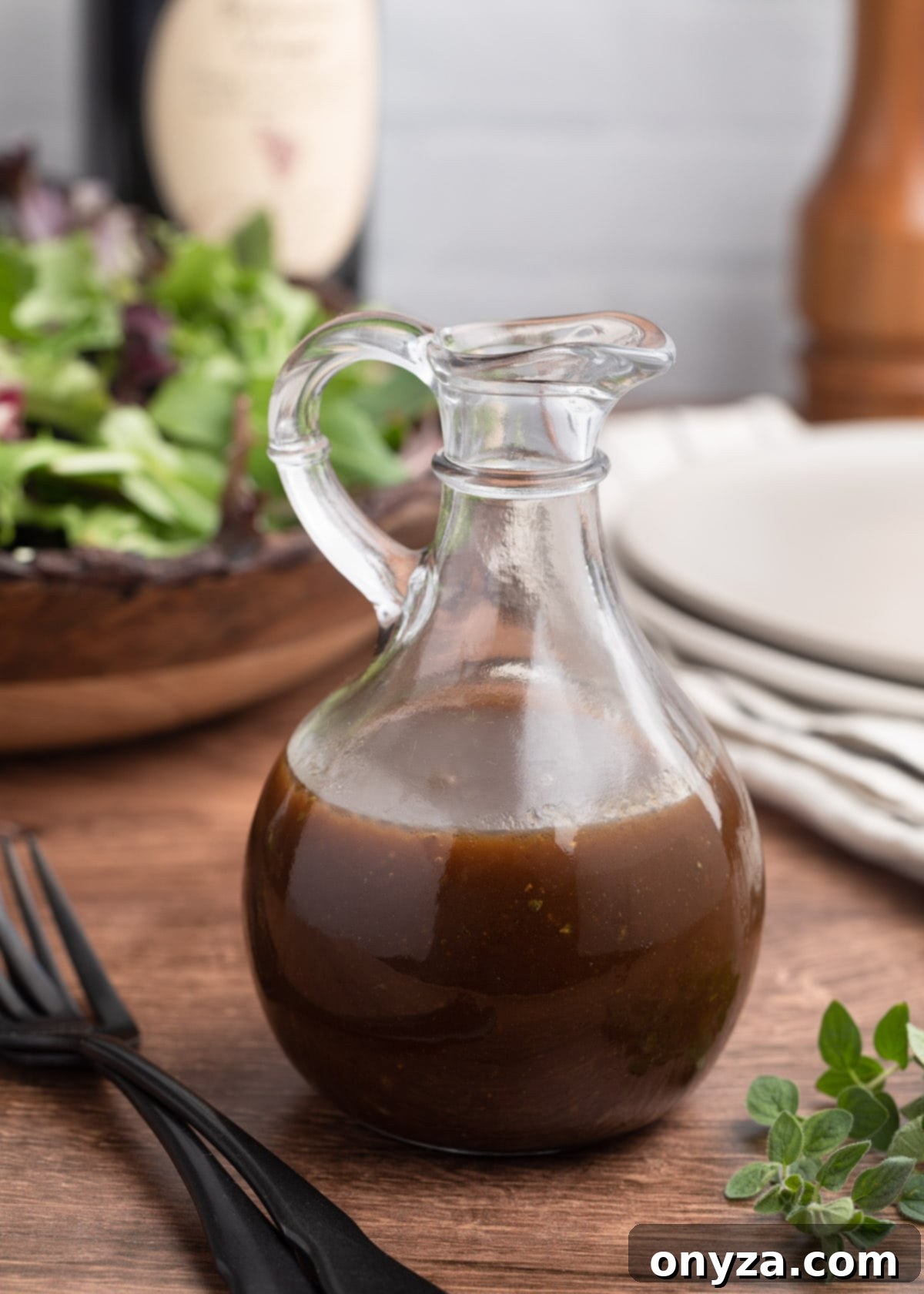
This post contains affiliate links. As an Amazon Associate, I earn a commission (at no additional cost to you) from qualifying purchases made by clicking these links. As always, all recommendations and opinions expressed are my own.
Homemade Balsamic Vinaigrette: Your Guide to Restaurant-Quality Salad Dressing at Home
Balsamic vinaigrette has long held a special place as one of my absolute favorite salad dressings, and for good reason. Its allure lies in its ability to deliver a deeply rich and complex flavor without ever feeling heavy or overwhelming. This versatile dressing pairs exceptionally well with a wide array of greens, from robust spinach and peppery arugula to delicate spring mixes, and even complements heartier salads featuring roasted vegetables, grilled proteins, or fresh berries. The harmonious blend of sweet, tangy, and savory notes creates a captivating taste experience that transforms a simple bowl of greens into an extraordinary culinary delight, making every bite a pleasure.
What’s truly remarkable is how incredibly simple and quick it is to prepare this gourmet dressing right in your own kitchen. In just about 10 minutes, you can have a fresh batch of restaurant-quality vinaigrette ready to use, completely free from the preservatives, artificial colors, high-fructose corn syrup, and excess sodium often found in their store-bought counterparts. The effort involved is minimal, certainly no more demanding than a quick trip to the grocery store, and the resulting flavor is simply unmatched in its freshness and vibrancy. With homemade balsamic vinaigrette, you gain complete control over the quality of your ingredients and the ability to tailor the taste to your exact preferences, ensuring a fresher, healthier, and undeniably more delicious dressing every single time. It’s a small change that makes a huge impact on your meals.
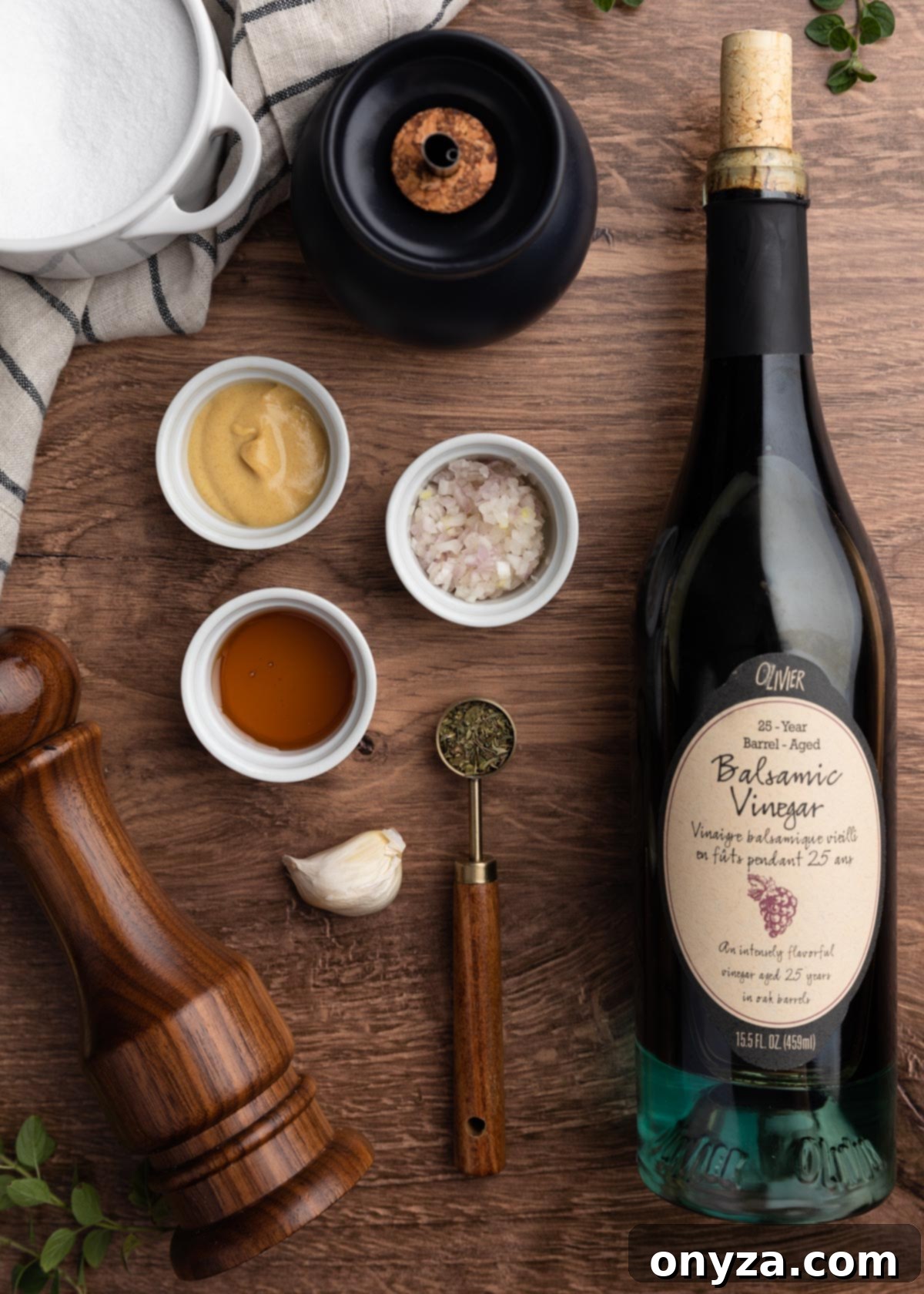
Essential Ingredients for the Perfect Homemade Balsamic Vinaigrette
Crafting an exceptional balsamic vinaigrette starts with selecting high-quality ingredients. Each component plays a crucial role in achieving that coveted balance of flavors and a beautifully emulsified, stable texture. Here’s a detailed look at what you’ll need and why each choice matters:
- Balsamic Vinegar: The Heart of the Dressing. For a vinaigrette boasting the deepest complexity and richest flavor, I wholeheartedly recommend using an aged balsamic vinegar, ideally sourced from Modena, Italy. These vinegars have been carefully aged, often in wooden barrels, which concentrates their flavors and introduces nuanced notes of fruit, wood, and spice. While a very expensive, decades-old balsamic is certainly a treat, a good quality, moderately aged option (think 10 to 25 years) will deliver fantastic results without breaking the bank. The quality of your balsamic will directly influence the final taste, providing the signature tangy-sweet base, so invest in the best you can reasonably afford for the most impactful flavor.
- Extra Virgin Olive Oil: The Smooth Foundation. Just like balsamic vinegar, not all extra virgin olive oils (EVOO) are created equal, and their flavor profiles can vary dramatically. Some EVOOs are distinctly fruity, buttery, and mild, while others can be quite peppery, grassy, or even carry an intense, bitter bite. For this vinaigrette, I prefer an EVOO with a medium pungency. This choice allows the dressing to have a pleasant fruity undertone with subtle peppery notes that linger in the background, without overpowering the delicate flavors of the other ingredients. Always ensure your EVOO is fresh; rancid oil will negatively impact the taste. Experiment with different brands to find an EVOO that suits your palate.
- Dijon Mustard: The Emulsification Dynamo. Dijon mustard is much more than just a flavor enhancer in this recipe; it’s a vital emulsifier. Its natural compounds help to bind the oil and vinegar, two liquids that typically resist mixing, into a smooth, cohesive, and stable dressing. Without Dijon, your vinaigrette would quickly separate, leaving you with distinct layers of oil and vinegar. Beyond its functional role, Dijon also contributes a subtle, tangy, and slightly spicy note that beautifully complements the balsamic, adding depth and a touch of sophistication to the overall flavor profile.
- Honey: The Sweet Balancer and Stabilizer. A touch of honey is essential for two primary reasons. Firstly, it adds a gentle, natural sweetness that perfectly counterbalances the inherent acidity of the balsamic vinegar, creating a more harmonious and rounded flavor profile. Secondly, honey also acts as an additional stabilizer, further aiding in the emulsion process and helping to prevent the dressing from separating too quickly. The exact amount of honey you’ll need can vary depending on the natural sweetness or tartness of your chosen balsamic vinegar, so it’s always best to add it gradually and taste as you go, ensuring a perfectly balanced dressing.
- Fresh Garlic and Shallot: Aromatic Foundations. These two aromatics are crucial for building a complex and fresh flavor base. Both garlic and shallot should be minced very finely. This ensures they disperse evenly throughout the dressing, allowing their pungent, savory notes to infuse seamlessly without any large, chunky bits that could disrupt the smooth texture. Minced garlic provides a robust, sharp flavor that is undeniably fresh, while shallots offer a milder, more delicate onion-like sweetness, creating a layered aromatic foundation that elevates the entire vinaigrette. Fresh is always best here for maximum impact.
- Dried Italian Herbs, Salt, and Pepper: The Seasoning Symphony. A blend of classic dried Italian herbs adds a fragrant, earthy dimension to the vinaigrette, evoking the essence of Mediterranean cuisine. My preferred blend typically includes thyme, oregano, basil, marjoram, and rosemary, though a good quality pre-mixed Italian seasoning works perfectly. Kosher salt or fine sea salt is used to enhance all the flavors, bringing them to life, while freshly-cracked black pepper provides a subtle warmth and a gentle kick that awakens the palate. These seasonings are vital for adjusting the dressing to your personal taste, bringing all the individual components into a cohesive and delicious whole.
When it comes to ratios, a classic starting point for balsamic vinaigrette is typically 1/4 to 1/3 cup of vinegar to 3/4 cup of olive oil. However, this is merely a guideline, not a strict rule. The ideal quantity of balsamic vinegar can vary significantly based on the specific flavor profile and acidity of the bottle you’re using, as well as your own personal preference for tanginess. Some balsamic vinegars are naturally sweeter and less acidic, while others are sharper. Don’t hesitate to adjust within this range, tasting and tweaking until you achieve the perfect balance that delights your palate and complements your salad ingredients.
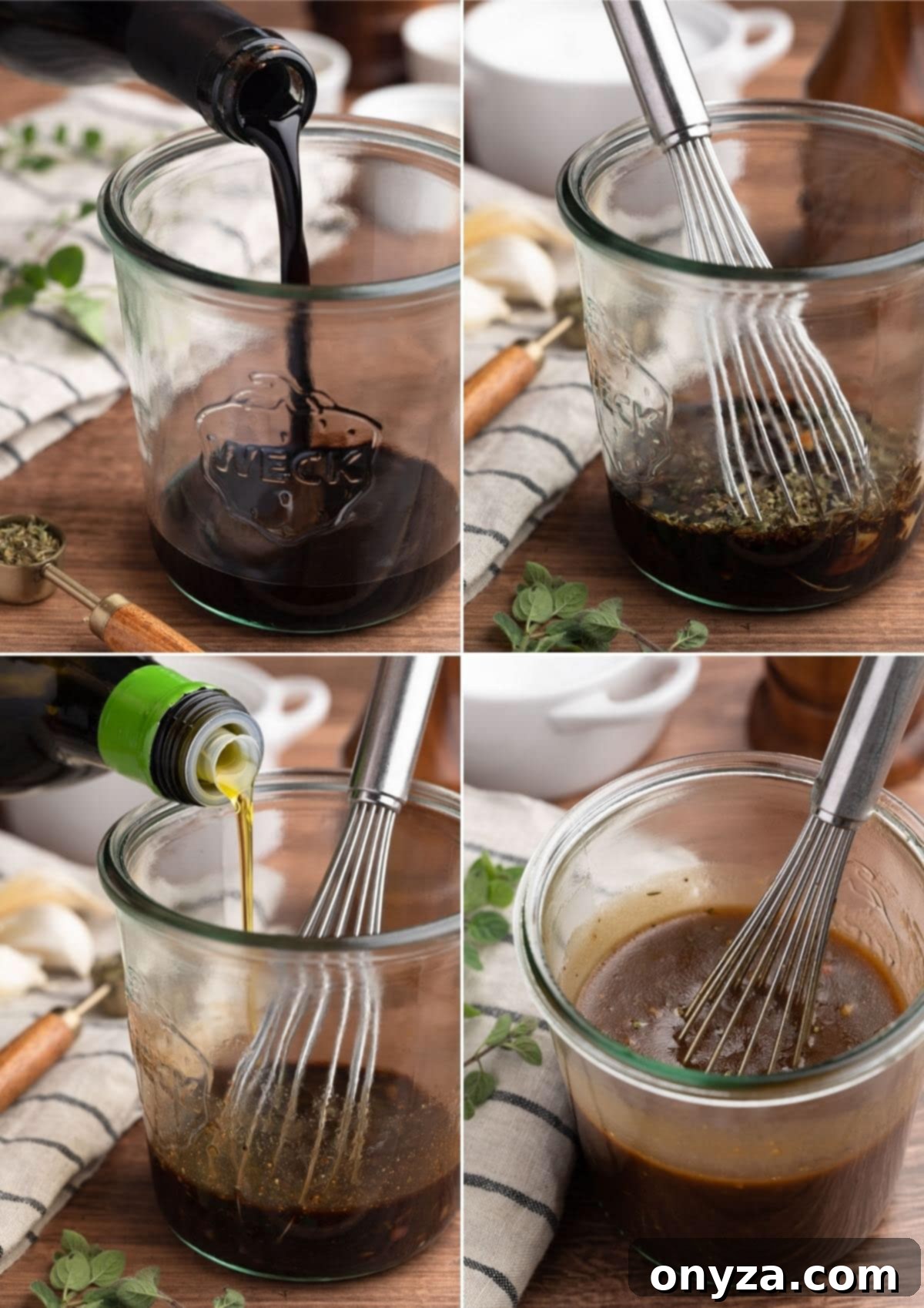
Two Simple Methods for Crafting Your Balsamic Vinaigrette
Making this delightful vinaigrette is incredibly straightforward, and you have two equally effective methods to choose from, depending on your preference and available tools: the classic whisking technique or the convenient shaking method. Both approaches yield a delicious dressing, but there are subtle differences to consider regarding their stability and preparation ease.
While both methods produce a wonderful vinaigrette, I’ve consistently found that the classic whisking method tends to result in a slightly more stable emulsion. This means it resists separation a bit longer, maintaining its smooth, uniform texture for a greater period. However, should your oil and vinegar begin to separate over time—which is entirely natural for homemade dressings without artificial stabilizers—a quick re-whisk or vigorous shake before serving will effortlessly re-emulsify it, restoring its perfect texture and vibrant flavor.
The Classic Whisking Method: Achieving a Perfect Emulsion
This method is ideal for those who enjoy a hands-on approach and want to ensure a stable, velvety emulsion that holds up beautifully. Begin by selecting a mixing bowl or a jar that is wide and deep enough to allow for comfortable and vigorous whisking without any risk of spillage. Into this vessel, combine your measured balsamic vinegar, finely minced shallot, minced garlic, honey, Dijon mustard, dried Italian herbs, kosher salt, and freshly-cracked black pepper. Whisk these ingredients together thoroughly until they are well combined, and the honey has completely dissolved into the vinegar mixture.
Once your aromatic base mixture is ready, the key to a successful and lasting emulsion lies in the slow and steady addition of the olive oil. While continuously whisking the balsamic mixture with consistent motion, gradually drizzle the extra virgin olive oil into the bowl in a thin, consistent stream. As you continue to whisk, you’ll observe a magical transformation: the mixture will begin to thicken, lighten in color, and turn opaque, eventually emulsifying into a beautifully smooth, glossy, and velvety dressing. This methodical process ensures that tiny droplets of oil are evenly suspended throughout the vinegar, creating a stable bond that prevents quick separation.
Chef’s Tip: Softening Garlic’s Pungency. If you find the raw garlic flavor too intense for your liking, here’s a simple trick to mellow it out: allow the minced garlic clove to sit directly in the balsamic vinegar for about 10 minutes before you add the remaining ingredients and begin emulsifying the dressing. This brief acidic soak will gently temper the garlic’s sharpness, integrating its flavor more smoothly and subtly into the vinaigrette’s overall profile.
The Shaken Vinaigrette Method: Quick and Convenient
For those times when speed and convenience are paramount, or if you prefer minimal cleanup, the shaken vinaigrette method is your go-to. This approach is incredibly simple and requires virtually no special equipment beyond a sturdy jar. All you need is a mason jar or any glass storage jar with a tight-fitting, secure lid.
Simply add all of your measured ingredients – the extra virgin olive oil, balsamic vinegar, minced shallot, minced garlic, honey, Dijon mustard, dried Italian herbs, kosher salt, and freshly-ground black pepper – directly into the jar. Secure the lid tightly, ensuring it’s completely sealed to prevent any leaks during the process. Then, grasp the jar firmly and shake it vigorously for about 30-60 seconds, or until all the ingredients are thoroughly combined and the mixture appears homogenous and creamy. This vigorous shaking action effectively emulsifies the dressing, though it might separate slightly faster than the whisked version due to the less controlled mixing. Just give it another good shake before each use to refresh the emulsion.
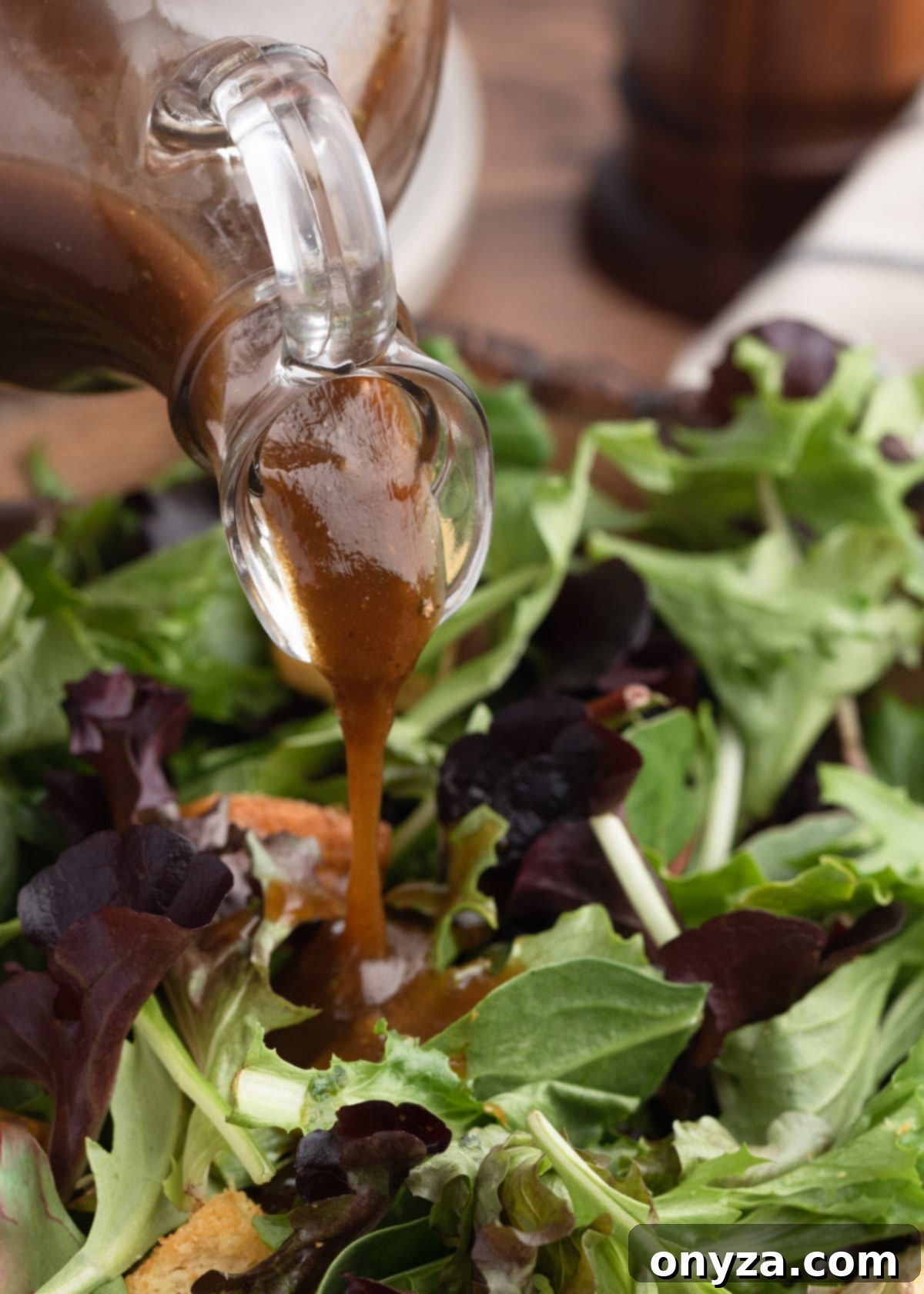
Your Top Questions About Homemade Balsamic Vinaigrette Answered
Here are answers to some of the most common questions about making and enjoying homemade balsamic vinaigrette, designed to help you master this versatile and delicious dressing.
Q. How long can I store homemade balsamic dressing?
A. Homemade balsamic vinaigrette, thanks to its fresh ingredients and lack of artificial preservatives, is best enjoyed within 5-7 days when stored properly. Always keep it in an airtight container, such as a specialized glass cruet or a simple glass storage jar, in the refrigerator. The cold temperature will help maintain its freshness and prevent spoilage. It’s perfectly normal for the dressing to thicken slightly in the refrigerator due to the olive oil solidifying. For optimal texture and flavor, I recommend taking it out and letting it sit at room temperature for 10-15 minutes before serving. This allows the oil to soften and the flavors to awaken. Always give it a quick whisk or shake just before drizzling over your salad to re-emulsify it and ensure a smooth, uniform consistency.
Q. My vinaigrette is too thick, or the flavor has too much “bite.” How can I fix it?
A. The consistency and intensity of your balsamic vinaigrette can indeed vary based on the specific brands and types of oil and vinegar you’ve used. If you find your dressing to be too thick, or if its flavor has an overpowering “bite” from the vinegar or fresh garlic, resist the urge to add more olive oil, which will only increase its richness without necessarily balancing the flavor. Instead, try whisking in a small splash of warm water, starting with about a teaspoon and adding up to a tablespoon as needed. This simple trick can effectively thin the dressing to your desired consistency and mellow out overly aggressive flavors without diluting the overall essence. Taste after each addition until you reach your perfect consistency and flavor balance.
Q. Can I use flavored balsamic vinegar in this recipe?
A. Absolutely! Using flavored balsamic vinegars is a fantastic way to experiment and customize your dressing, adding exciting new dimensions to its taste profile. Depending on the season or your culinary mood, you could try Fig Dark Balsamic for a rich, sweet undertone perfect for fall salads, Raspberry Dark Balsamic for a bright, fruity twist that’s wonderful in spring, or Red Apple Dark Balsamic for a crisp, autumnal note. Just keep in mind that many fruit-infused balsamic vinegars tend to be sweeter than traditional varieties. If you opt for a flavored balsamic, be sure to adjust the amount of honey specified in the recipe accordingly, potentially reducing it significantly to avoid an overly sweet dressing.
Q. What salads pair best with balsamic vinaigrette?
A. Balsamic vinaigrette is incredibly versatile and enhances a wide variety of salads. It’s a classic choice for simple green salads, especially those with delicate spring mix, peppery arugula, or hearty spinach. It also shines brightly with salads featuring fresh berries, crumbled goat cheese, toasted nuts, or sliced red onion. For a more substantial meal, try it with grilled chicken or steak salads, traditional Caprese salads, or roasted vegetable salads. Its tangy-sweet profile beautifully complements both robust flavors and adds a welcome brightness to lighter dishes, making it a reliable, go-to dressing for almost any occasion and ingredient combination.
Q. Can I use balsamic vinaigrette to marinate chicken or other meats?
A. While you technically *could* use this vinaigrette as a marinade, for optimal flavor penetration and tenderization when marinating meats like chicken, pork, or even firm tofu, I generally recommend using a dedicated marinade recipe. Marinades are typically formulated with different, often higher, ratios of acid (vinegar) to oil, along with specific seasonings, to achieve better flavor absorption and tenderizing effects on meat fibers. My dedicated Balsamic Chicken Marinade recipe, for instance, often uses a 50/50 proportion of olive oil to balsamic vinegar. This higher acidity level in the marinade helps to break down muscle fibers more effectively, resulting in a more flavorful and tender final product than a standard salad vinaigrette would typically provide.
Beyond Salads: More Ways to Enjoy Balsamic Vinegar
Balsamic vinegar’s rich, complex, and versatile flavor isn’t just reserved for salads. It’s an exceptional ingredient that can elevate many different dishes, adding depth and a gourmet touch. Explore these other delicious recipes that showcase the incredible breadth and depth of balsamic vinegar beyond a simple dressing:
- Fig Salad with Goat Cheese and Baby Arugula
- Blue Cheese Crusted Steak with Balsamic Shallots
- Mixed Citrus Salad with Honey-Balsamic Vinaigrette
- Grilled Balsamic Chicken Salad
- Balsamic-Roasted Strawberry Baked Brie
CRAVING MORE? Don’t miss out on delicious recipes and culinary inspiration! Subscribe to my newsletter today and join me on Facebook, Pinterest, and Instagram for the very latest recipes, cooking tips, and foodie news delivered straight to your feed.
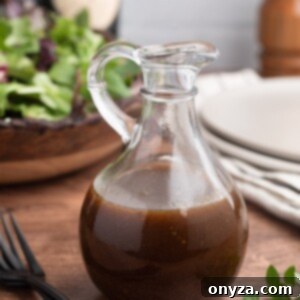
Balsamic Vinaigrette
by Amanda Biddle
Craft a restaurant-quality salad at home in minutes with this easy, non-separating homemade Balsamic Vinaigrette recipe. Fresh, flavorful, and incredibly versatile!
Prep Time: 10 minutes
Total Time: 10 minutes
Servings: 8 servings (2 tablespoons each)
Ingredients
- ¾ cup extra virgin olive oil
- ¼ to ⅓ cup aged balsamic vinegar (adjust to taste, see notes)
- 1 tablespoon minced shallot
- 1 medium garlic clove, minced (about ½ to ¾ tsp)
- 1 teaspoon honey (additional, if needed, to taste)
- 1 teaspoon Dijon mustard
- ½ teaspoon dried Italian herbs (e.g., thyme, oregano, basil, marjoram, rosemary)
- ¼ teaspoon kosher salt
- ½ teaspoon freshly-ground black pepper
Instructions
- In a medium bowl or glass jar, combine the balsamic vinegar, minced shallot, minced garlic, honey, Dijon mustard, dried Italian herbs, kosher salt, and freshly-ground black pepper. Whisk these ingredients together until well combined and the honey has dissolved.
- If using the whisking method: While continuously whisking the balsamic mixture, slowly and steadily drizzle the extra virgin olive oil into the bowl. Continue whisking until the dressing thickens and emulsifies into a smooth, glossy consistency.
- If using the shaking method: Add all ingredients (oil, vinegar, shallot, garlic, honey, mustard, herbs, salt, pepper) into a mason jar or other tightly sealable glass container. Secure the lid and shake vigorously for 30-60 seconds until all ingredients are thoroughly combined and emulsified.
- Taste the vinaigrette and adjust seasonings as needed, adding more salt, pepper, or honey to achieve your desired flavor balance.
- Store the homemade balsamic vinaigrette in an airtight container in the refrigerator for up to 5-7 days.
- Before serving, allow the dressing to stand at room temperature for 10-15 minutes to loosen any solidified olive oil. Give it a quick whisk or shake to re-emulsify if any separation has occurred.
Notes
The ideal amount of balsamic vinegar and honey you use will depend significantly on the specific brand, age, and natural sweetness or tartness of your balsamic. Always taste and adjust these quantities to suit your personal preferences for a perfectly balanced dressing.
For additional tips on ingredient selection, substitutions, variations, and troubleshooting common issues, please refer to the comprehensive FAQ section earlier in this article.
Nutrition Estimate
Serving: 2 tablespoons | Calories: 191 kcal | Carbohydrates: 3g | Protein: 1g | Fat: 20g | Saturated Fat: 3g | Polyunsaturated Fat: 2g | Monounsaturated Fat: 15g | Sodium: 82mg | Potassium: 19mg | Fiber: 1g | Sugar: 2g | Vitamin A: 3IU | Vitamin C: 1mg | Calcium: 7mg | Iron: 1mg
Nutrition information is automatically calculated and should be used as an approximation only. Actual values may vary based on specific ingredients and preparation methods.
Please note that our recipes have been developed using the US Customary measurement system and have not been tested for high altitude/elevation cooking and baking. Adjustments may be necessary for different environments.
Enjoyed this recipe? We’d love to hear from you! Please consider rating and leaving a comment below to share your experience and any delicious variations you tried.
